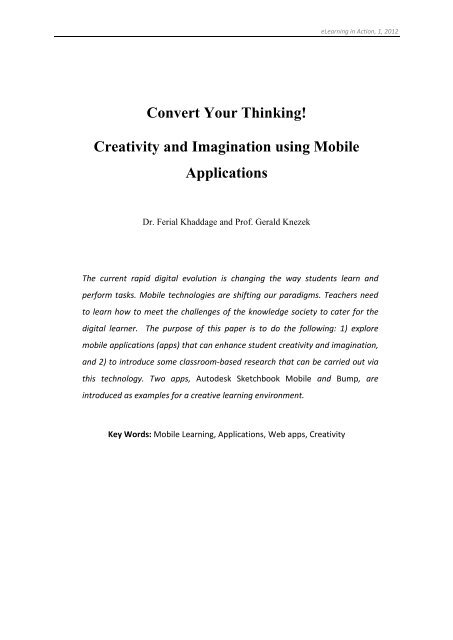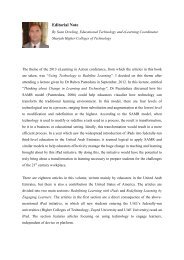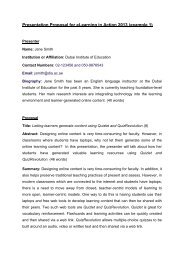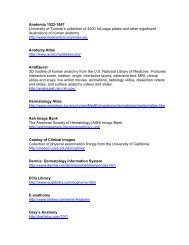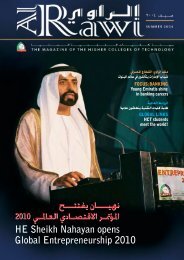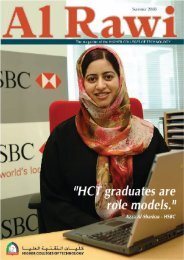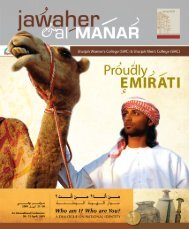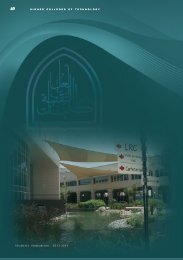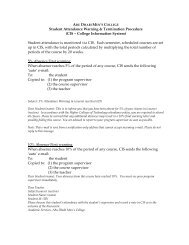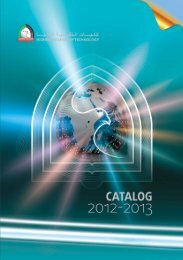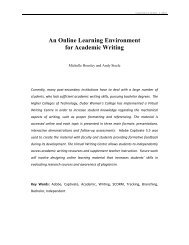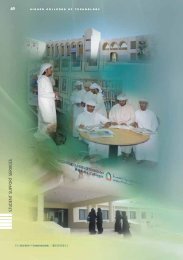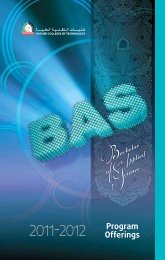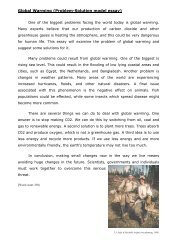Convert Your Thinking! - Sharjah Women's College - Higher ...
Convert Your Thinking! - Sharjah Women's College - Higher ...
Convert Your Thinking! - Sharjah Women's College - Higher ...
You also want an ePaper? Increase the reach of your titles
YUMPU automatically turns print PDFs into web optimized ePapers that Google loves.
eLearning in Action, 1, 2012<br />
<strong>Convert</strong> <strong>Your</strong> <strong>Thinking</strong>!<br />
Creativity and Imagination using Mobile<br />
Applications<br />
Dr. Ferial Khaddage and Prof. Gerald Knezek<br />
The current rapid digital evolution is changing the way students learn and<br />
perform tasks. Mobile technologies are shifting our paradigms. Teachers need<br />
to learn how to meet the challenges of the knowledge society to cater for the<br />
digital learner. The purpose of this paper is to do the following: 1) explore<br />
mobile applications (apps) that can enhance student creativity and imagination,<br />
and 2) to introduce some classroom-based research that can be carried out via<br />
this technology. Two apps, Autodesk Sketchbook Mobile and Bump, are<br />
introduced as examples for a creative learning environment.<br />
Key Words: Mobile Learning, Applications, Web apps, Creativity
eLearning in Action, 1, 2012<br />
Introduction<br />
Mobile tools and applications (apps) are shifting the learning environment to a new dynamic,<br />
creative, connected, sharable, flexible, collaborative and portable context. For almost a<br />
decade, there has been a global movement toward the integration of mobile technologies for<br />
teaching and learning (Belt, 2001; Tatar et al., 2003; Attewell, 2005; Khaddage, Lanham &<br />
Khou, 2009; Sharples et. al, 2010; Khaddage & Knezek, 2011). The paradigms of<br />
constructivist knowledge representation (Papert, 1980; Foreman & Pufall, 1988) and<br />
Discovery Learning (Bruner, 1960, 1961, 1996) provide well-established theoretical<br />
rationales for anticipating that mobile applications promoting self-directed learning could<br />
contribute to the depth and breadth of mastery of knowledge. Nevertheless, mobile apps are<br />
yet to be fully explored by educational institutions and teachers are still reluctant to integrate<br />
this technology (Khaddage, Lattemann & Bray, 2011).<br />
Knowledge mastery has traditionally been a pillar of formal learning in modern society.<br />
However, the definition of 21st Century Skills has expanded well beyond mastery of<br />
knowledge. Creativity is another important component of 21st century learning. As stated by<br />
Boden (2001), creativity plays an important role in the way individuals learn. Craft (1997)<br />
suggested that a creative learning environment can encourage a student to experiment and to<br />
seek out different possible outcomes. Thus, what students discover by themselves will be<br />
remembered and valued for years to come (Craft, 1997).<br />
A basic tenet of this paper is that creativity can be considered an essential life skill through<br />
which individuals can develop their potential to use their imagination and become capable of<br />
creating, exploring and expressing themselves (Edmonds & Candy, 2002). Therefore, a<br />
digital environment such as using mobile apps can grant students flexibility, connectivity and<br />
a wide variety of options. Mobile apps can give students the opportunity to discover new<br />
ideas, to implement these ideas and to gather validation data in order to confirm for<br />
themselves new knowledge and develop deeper understanding. These students with deep<br />
understanding can then grow up to become the makers and inventors of the future.<br />
Many authors have described and defined creativity and discussed methods of creativity<br />
adoption (Boden, 2001; Edmonds & Candy, 2002; Cropley, 2001; Santanen et. al, 2002;<br />
Loveless, 2002), but we define creativity in a digital mobile environment as the ability to<br />
1
eLearning in Action, 1, 2012<br />
develop novel, unique, useful ideas/approaches during informal experiments and apply them<br />
to constructing knowledge and understanding and making sense of one’s surroundings. This<br />
approach to discovery and learning in a mobile learning environment is capable of<br />
encouraging motivation and risk-taking by individuals, as pointed out by Leach (2001) and<br />
Edmonds and Candy (2002) when they discussed creativity in teaching and learning.<br />
Currently, educational institutions, teachers and students are being challenged to demonstrate<br />
an active engagement in the open world as described by Bonk (2009) in his book “The World<br />
is Open.” As society is rapidly changing and the world is open, there is an interaction<br />
between communities, creative processes, knowledge sharing and wider social contexts, thus<br />
mobile technologies and applications can have a role in these processes and can be integrated<br />
as a set of tools to be used to enhance the creative process. Therefore, teachers as well as<br />
students can use mobile apps to support creative autonomy and collaboration, to judge values<br />
and to inform discovery and understanding to construct knowledge.<br />
Students, as well as some teachers, are already using mobile apps in informal situations, but<br />
educational institutions are yet to formally recognize this type of delivery mechanism<br />
(Knezek, Lai, Khaddage & Baker, 2011). Currently connectivity and communication has<br />
moved to mobile phones and tablets such as iPads. Mobile apps are seen as an added<br />
opportunity for education as they can be used for sketching/designing, management,<br />
inspiration, reading, writing and organizing, and all of this can help students work,<br />
communicate, discover, study, collaborate, engage, share, read, experiment and create, having<br />
fun and being creative at the same time. These emerging mobile apps and technologies are<br />
already appearing in some educational institutions to deliver learning in interest-based e-<br />
communities, forums, synchronous environments and through social networking platforms<br />
(Khaddage et al., 2011). There have been many school reforms such as student response<br />
systems, games for math and multimedia, videos on demand and mobile phones and SMSs<br />
for teaching and learning, but none are yet to have an impact on the way students perform<br />
tasks like the current trends in mobile app technologies. There have been some successful<br />
accounts of integrating technologies and mobile applications to form a creative learning<br />
process. One good example of successful integration is at Central Elementary School in<br />
Escondido, California. There a fourth-grade classroom used iPod Touches to help students<br />
learn reading via applications. The outcome was positive, in that every student’s reading<br />
2
eLearning in Action, 1, 2012<br />
score went up, and the overall progress rates were two to three times those of other<br />
classrooms in the district who did not use apps for this purpose (Apple, 2010).<br />
In the following section, we introduce mobile applications for teaching and learning and<br />
describe how mobile applications can be used to empower creativity amongst students. This<br />
introduction may encourage teachers and instructors who are skeptical about using mobile<br />
apps to be receptive towards bringing these technologies into the classroom and using them<br />
effectively to meet students’ needs so that their students can in turn become creative in their<br />
own self-directed learning.<br />
The probable mechanism through which mobile technologies and applications empower<br />
creativity is by offering students a learner-centred approach to learning environments that can<br />
be flexible, open and informal; hence catering to today’s digital learners. The integration of<br />
mobile app technologies and tools to empower creativity could also assist pedagogical<br />
design. By bringing to the forefront the social, spatial, temporal and contextual issues related<br />
to a student’s active engagement with the “HERE” and “NOW” of learning experiences,<br />
teaching today can focus on how to empower students to be inventors, creators and leaders in<br />
their field (Khaddage & Knezek, 2011). Therefore, we believe that mobile apps can assist in<br />
applying creativity in teaching and learning.<br />
The Study<br />
In the current study, two apps were used to demonstrate how mobile applications and<br />
technologies can be used to enhance creativity among students. The two apps are:<br />
<br />
Autodesk SketchBook Mobile, which is a very powerful drawing app enabling<br />
multimedia students to draw smooth curves with their fingers. It has a very simple<br />
interface and many unique features to help student use their imagination. Features<br />
include image layers, multiple levels of undo and redo, image transformations for<br />
rotate and scale, zoom ups, pressure-sensitive brush tips, and paintbrush, pencil,<br />
marker, felt pen, and texture brush tools. Figure 1 below contains an illustration of the<br />
Sketchbook app.<br />
3
eLearning in Action, 1, 2012<br />
Figure1. Autodesk SketchBook Mobile.<br />
<br />
Bump, which allows users to share information, photos and other objects between<br />
phones. It lets users bump their phones together to exchange information, photos or<br />
even other apps. Figure 2 contains an illustration of the Bump app activity.<br />
Figure 2. the Bump app on an iPhone.<br />
4
eLearning in Action, 1, 2012<br />
During the study, students were asked to create an image using the Autodesk SketchBook<br />
Mobile and then share the image with others using the Bump app. The assigned task was<br />
completed informally during class time. Twenty-four first year Computing and Multimedia<br />
undergraduate students served as the subjects for this experiment. During class time the<br />
students (n = 24) were asked to download and install the two apps, Autodesk SketchBook<br />
Mobile and Bump, on their smart phones.<br />
Firstly, students were asked to experiment with the Bump app to share existing data and<br />
images on their phones. Then, students were asked to create an image using Autodesk<br />
SketchBook Mobile. After the image was completed, students were asked to share their<br />
images with each other. Using Bump, they only had to open the image and bump their phones<br />
together. The selected image then jumped from one phone to another. The receiving student<br />
needed only to confirm the transfer (this is a good feature within the app as it prevents<br />
accidental exchange) and the transfer of the image was then completed and the synchronized<br />
exchange took place. The students were able to give each other feedback on the specific<br />
image exchanged and shared comments and recommendations.<br />
Students were excited to use both apps and they stated that using their mobile phones and<br />
using app technology allowed them to learn in a challenging, collaborative and creative<br />
atmosphere. They also reported that these apps are fun and creative to use. They were able to<br />
experiment in creating their own image using their mobile phones and they also shared some<br />
relevant information related to their course with their peers. The majority of students (n = 20)<br />
found the app fun and exciting to use. One student stated that, “I would never get bored<br />
learning in this way, it’s fun, like playing games”. They stated that the apps are effective<br />
since they are also compatible with a range of mobile devices, from Android to iPhone (iOS),<br />
and vice versa, so this enabled a device independent exchange environment. Therefore, apps<br />
can be effective for teaching and learning, and they may be also used in alternative methods;<br />
for example, students may be asked to research a topic or discuss a specific area and find<br />
information from a variety of sources using a mobile app, then bring the information back to<br />
share with other students. This method could encourage students to use their creative skills to<br />
generate ideas from their surroundings; it would offer flexibility and portability to learn,<br />
share, collaborate and communicate.<br />
5
eLearning in Action, 1, 2012<br />
Discussion<br />
A wide range of creativity-supporting apps could be used, for example, musical apps could be<br />
used to turn tablets or iPads into musical instruments and mobile phone apps can be used as<br />
chemistry or programming tools. This type of approach was also advocated by Lai, Khaddage<br />
and Knezek (2011) during their discussion of formal and informal learning environments and<br />
how mobile apps and technologies can bridge the gap and bring these two learning<br />
environments together. This can enhance creativity amongst students and teachers and can<br />
bring a unique approach to teaching and learning that can encourage beneficial educational<br />
activities, such as the following:<br />
<br />
<br />
<br />
<br />
<br />
<br />
<br />
<br />
<br />
<br />
<br />
<br />
<br />
<br />
Get students up to speed quickly: students watch video demos and follow along on<br />
their own mobile device via the app;<br />
Create, test and share learner-generated content;<br />
Bring students’ creative designs to life with animation within the app;<br />
Dynamically import relevant content to their devices;<br />
Join a community to learn and explore;<br />
Get access to a wealth of materials;<br />
Become an expert, engage and create;<br />
Engage in highly innovative learning approaches;<br />
Create real-time effects for enhanced learning experiences;<br />
Gain control over text layout;<br />
Create multitasking functions for different apps;<br />
Enrich student experiences, enhance and improve performance;<br />
Create variety of content modules for a wide range of mobile devices;<br />
Make learning fun and interesting.<br />
The optimal mixture of formal and informal learning has not yet been definitively<br />
established. Further research is needed in this area. Figure 3 below contains an illustration of<br />
the features of the mobile apps examined in this article. It also represents how the apps can<br />
connect together to form an effective, creative learning environment.<br />
6
eLearning in Action, 1, 2012<br />
Figure 3. Mobile Apps Features.<br />
As illustrated in figure 3, students can use mobile app technologies to demonstrate a variety<br />
of tasks. Students can use some of the already-existing, exciting educational apps to complete<br />
learning activities. By using mobile apps, these tasks could be performed anywhere and<br />
anytime and the outcome should be acknowledged and recognized by educational institutions<br />
and teachers. It is also important that schools ensure that mobile apps’ initiatives for teaching<br />
and learning are aligned with their educational objectives and course outcome and guidelines.<br />
Educational institutions should design and integrate tools and devices that can be used across<br />
subjects in classrooms.<br />
Conclusion<br />
Mobile apps are growing at an enormous speed; the prospects of harnessing these apps for the<br />
purposes of enhancing teaching and learning seem endless. Mobile apps have the power to<br />
enhance creativity amongst students of all ages. As illustrated in the study with the two apps<br />
(Bump and Autodesk SketchBook Mobile), mobile apps are capable of creating a proactive<br />
learning atmosphere that will enable a synergy of flexible collaborative and creative learning<br />
environments. Mobile apps can benefit teachers as well as learners. Their capacity to bridge<br />
formal and informal learning offers the promise of fulfilling the dreams of constructivist and<br />
discovery learning visionaries more than 30 years after the development of these theoretical<br />
perspectives.<br />
7
eLearning in Action, 1, 2012<br />
About the Authors<br />
Dr. Ferial Khaddage is a recent I.T. Faculty at the <strong>Sharjah</strong> <strong>Higher</strong><br />
<strong>College</strong>s of Technology in the UAE. She is a former lecturer/researcher at<br />
Deakin University, Melbourne Australia. Ferial’s research interest is<br />
mobile learning technologies and applications in education and has<br />
published widely in the area. Ferial is an active member of AACE and an<br />
executive committee and founder of the Global Learn Asia Pacific,<br />
Global Conference on Learning and Technology.<br />
dr.ferial.khaddage@hct.ac.ae<br />
Prof. Gerald Knezek is Regents Professor of Learning Technologies at<br />
the University of North Texas and Director of the Institute for the<br />
Integration of Technology into Teaching & Learning at UNT. He is<br />
currently Lead Principal Investigator for the US National Science<br />
Foundation ITEST Project MSOSW (#0833706), and was Co-Principal<br />
Investigator for a US Fund for Improvement for Post-Secondary<br />
Education project titled simMentoring(#P116B060398, 2006-2010).<br />
Further information is provided in his Vita.<br />
References<br />
Apple.com (2011). Apps for educational use. Retrieved from<br />
http://www.apple.com/webapps/entertainment/highesteducation.html<br />
Attewell, J. (2005). From research and development to mobile learning: Tools for education<br />
and training providers and their learners. Proceedings of mLearn 2005. Retrieved from<br />
http://www.mlearn.org.za/CD/papers/Attewell.pdf<br />
Belt, H. (2001), Wireless Devices in the Classroom. Learning and Training Innovations.<br />
Retrieved from http://www.ltimagazine.com/<br />
8
eLearning in Action, 1, 2012<br />
Boden, M.A. (2001). Creativity and Knowledge. In A. Craft, B. Jeffrey & M. Leibling (eds.),<br />
Creativity in Education (pp. 95-102). London and New York: Continuum.<br />
Bonk, C. J. (2009). The World is Open: How Web Technology is Revolutionizing Education.<br />
San Francisco, CA: Jossey Bass.<br />
Bruner, J. (1960). The Process of Education. Cambridge, MA: Harvard University Press<br />
Brunner, J. (1961). The act of discovery. Harvard Educational Review, 31, 21-32.<br />
Bruner, J. (1996). The Culture of Education. Cambridge, MA: Harvard University Press<br />
Craft, A. (1997). Can you teach creativity. Nottingham: Education Now Publishing cooperative.<br />
Creativity in Education. London and New York: Continuum.<br />
Cropley, A.J. (2001). Creativity in education and learning: a guide for teachers and<br />
educators. London, UK: Kogan Page Limited.<br />
Edmonds, E., & Candy, L. (2002). Creativity, art practice, and knowledge. Communications<br />
of the ACM 45, 10, 91-95.<br />
Foreman, G., & Pufall, P. (Eds.) (1988). Constructivism in the computer age. Hillsdale, NJ:<br />
LEA.<br />
Khaddage, F., Lanham, E., & Zhou, W. (2009) Mobile Phones as a Learning Device, Is It<br />
Time to Stop the Ban? IADIS International Conference of Mobile Learning 2009<br />
Proceedings (p. 347). Barcelona, Spain.<br />
Khaddage, F., & Knezek, G. (2011). Device Independent Mobile Applications for Teaching<br />
and Learning: Challenges, Barriers and Limitations. Proceedings of Global Learn Asia<br />
Pacific (pp. 1-7). Chesapeake, VA: AACE.<br />
Khaddage, F. Lattemann, C., & Bray, E. (2011). Mobile Apps Integration for Teaching and<br />
Learning,(Are Teachers Ready to Re-blend? Proceedings of Society for Information<br />
9
eLearning in Action, 1, 2012<br />
Technology & Teacher Education International Conference 2011 (pp. 2545-2552),<br />
Chesapeake, VA: AACE.<br />
Knezek, G., Lai, K-W., Khaddage, F., & Baker, R., (2011). TWG 2: Student Technology<br />
Experiences in Formal and Informal Learning. EDUSummIT 2011, June 2011, Paris.<br />
Lai, K-W. Khaddage, F., & Knezek G. (2012) Blending student technology experiences in<br />
formal and informal learning. The Journal of Computer Assisted Learning international<br />
journal (JCAL) (in press).<br />
Leach, J. (2001). A hundred Possibilities: Creativity community and ICT. In A. Craft, B.<br />
Jeffrey & M. Liebling (Eds.). Creativity in Education. London and New York: Continuum.<br />
Loveless,( 2002). Literature review in creativity, new Technologies and learning.A report for<br />
NestaFuturelab. Bristol: NESTA Futurelab<br />
Papert, S. (1980).Mindstorms: Children, computers, and powerful ideas. New York: Basic<br />
Books.<br />
Santanen, E., Briggs, R., Jan de Vreede, G.(2002). Toward an understanding of creative<br />
solution generation. Proceedings of the 35th Hawaii International Conference on System<br />
sciences, (pp. 2899 – 2908). Hawaii.<br />
Sharples, M., Taylor, J., Vavoula, G. (2010). A Theory of Learning for the Mobile Age.<br />
Medienbildung in neuenKulturräumen 2010, II, 87-99. Wiesbaden: VS<br />
VerlagfürSozialwissenschaften.<br />
Tatar, D., Roschelle, J., Vahey, P., & Penuel, W. R. (2003). Handhelds Go To School:<br />
Lessons Learned. IEEE Computer, 36(9), 30-37.<br />
10


